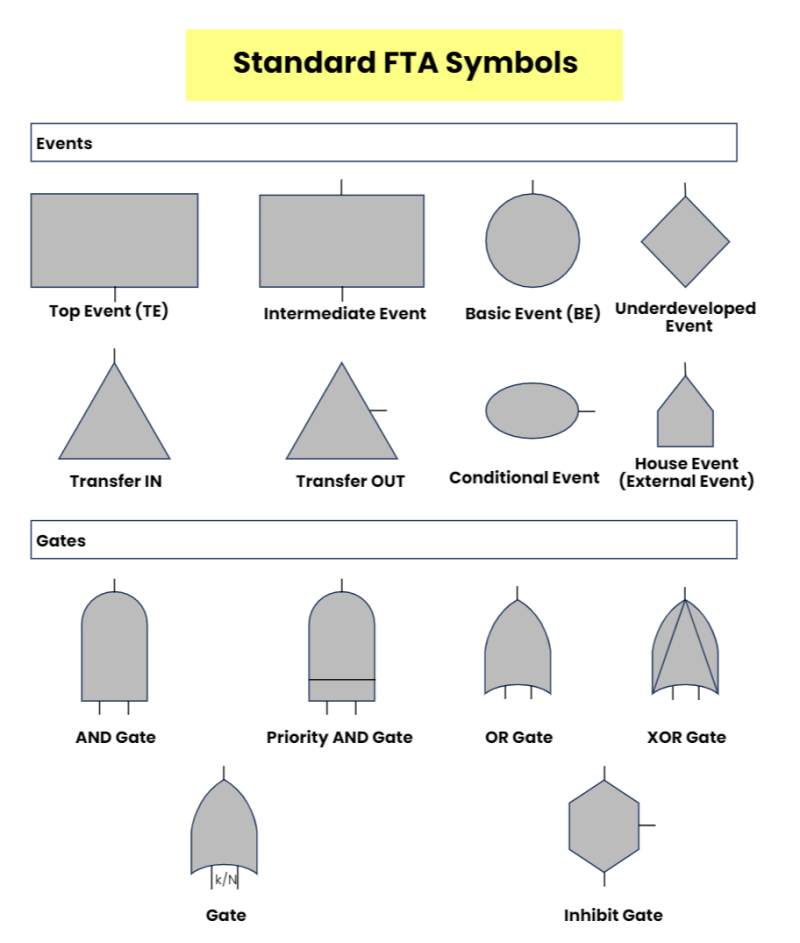A Complete List of Fault Tree Analysis Symbols
1. What Are Fault Tree Analysis Symbols
Fault tree analysis is used across many industries, including engineering, high profile industries where faults may disrupt the life of many such as power transmission and also in software engineering. Since it is a widely used tool, we need some standard fault tree analysis symbols identified largely, and everyone on the team or in multiple teams can relate with their meaning. Hence, we use a standard set of fault tree symbols in the diagrams.
There are two basic types of fault tree diagram symbols: they are events and logic gates. Events are the conditions or faults causing or leading to the main failure. Different fault tree analysis symbols show if the event is normal, independent, conditional, or contributing. Events are the blocks or conditions that happen. The gate fault tree analysis symbols, on the other hand, show the logical relationship among different events and other elements in the fault tree analysis.

Source: EdrawMax Community
2. Fault Tree Analysis Symbols Explained
2.1 Event Symbols
An event block in a fault tree uses several graphical block representations to show different types of events. The primary or basic failure event is represented with a circle. In contrast, an external event that is guaranteed or expected to occur uses a fault tree analysis symbol that looks like a house. Similarly, there are undeveloped events and conditioning events with their specific symbols discussed in the following table.
| Symbol | Name | Description |

|
Basic Event | A basic initiating failure fault |

|
External Event (House Event) | An event that is normally expected or guaranteed to occur. Generally, they have a fixed probability of 0 or 1. |

|
Undeveloped Event | Undeveloped events need no further breakdown. It is an event that is not further developed because the further analysis is not possible because of a lack of information. It is a basic event that does not need resolution. |

|
Conditioning Event | A conditioning event is a specific condition or restriction that can apply to any gate. |
The below FTA diagram graphically analyzes the cause and effect of a fire explosion. It shows different events that may lead to an explosion, such as Electrostatic discharge is not grounded or if the sensory part of the equipment fails. The logical gates connect the possible events to show how they can influence the top event.

Source: EdrawMax Community
2.2 Gate Symbols
Gate symbols describe the logical relationship between input and output events causing the main event. These fault tree analysis symbols are derived from Boolean logic symbols. The AND and OR gates and others are the basic gates that show how the output event occurs when a certain number of the input events occur. Let us see the detailed description of the gates in the following table.
| Symbol | Name | Description |

|
AND Gate | In an AND gate, the output event is positive if all input events occur. In system reliability terms, we can say that all components must fail for the system to fail. |

|
OR Gate | In an OR gate, the output event happens even if one of the input events occurs. In system reliability terms, this implies that if any input component fails, then the system will fail. |

|
Exclusive OR gate | Any but not all, this is the rule of exclusive OR gate. An output event only occurs if one of the input conditions is met, but not if all conditions are met. |

|
Priority AND gate | Priority AND gate mean the output occurs only after several input events occur in a specific sequence. |

|
Inhibit gate | An event will only occur if all input events occur and an additional, conditional event also takes place. An inhibit gate is an AND gate with an additional event. |
This water pump failure analysis shows that valve failure and valve closed events are combined by an AND gate. It means if both events take place, the water pump will fail. In the second branch, if any single or more than one of the events from the faulty indicator, light fail, control command fails, or operator unable to open valve takes place, the water pump will fail.

Source: EdrawMax Community
2.3 Transfer symbols
Transfer symbols are a convenient means to connect related fault trees, including fault trees of a subsystem, to its system.
| Symbol | Name | Description |

|
Transfer in | Transfer in fault tree analysis symbol indicates that the tree is developed further at another point within the tree. |

|
Transfer out | Transfer out shows that this portion of the tree is attached to another location within the same tree. |
In the below FTA tree, you can see two transfer controls. These controls show that these points are connected within the same tree. It means that point A and point B are connected.

Source: EdrawMax Community
3. Tips for Using Fault Tree Analysis Symbols
EdrawMax Online is an excellent drawing software supporting 280+ types of diagrams and drawings. It has separate comprehensive libraries for each type of diagram. So, we also have a fault tree analysis symbol library with all event, logic, or gate and transfer controls. Also, save time and effort by using the fully customized designer-made templates for common FTA from many fields available at EdrawMax Community for a quick start.
Here are some tips for using EdrawMax to use fault tree analysis symbols.
3.1 Use a Professional Fault Tree Analysis Maker
Find fault tree analysis symbols at EdrawMax Online>Symbol Library>Business>Fault Tree Analysis. You will see a complete library with an exhaustive collection of fault tree symbols. 
3.2 Create Symbols by Yourself
EdrawMax Online has a comprehensive symbols library for events, gates, and transfer fault tree analysis symbols. However, if you want to add any unique symbol or graphic element, you can easily do it with a few clicks. You can import images, symbols, or data from files format such as SVG, VSSX, etc. Navigate to the library option on the left-hand sidebar and click on the import icon. In the new pop-up window, you will find options for importing your file in different formats.
You can also learn more from this video. YouTube.
4. Conclusion
While performing a fault tree analysis, you systematically determine the reason for an unwanted event using the exclusive fault tree analysis symbols. It is used in many fields, especially in industries where the repercussions of failures are very serious. So in some situations, the minimum criterion for success is that no single failure should occur that can cause loss of control over the process. While in other industries, there is more tolerance for failure, quick recovery is needed, and FTA is a handy tool for identifying and correcting the fault. Using EdrawMax Online saves a lot of time and effort while drawing the FTA and hence is a great support in critical situations. Find more fault tree analysis examples in the templates community.









